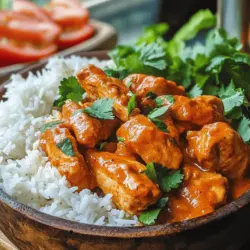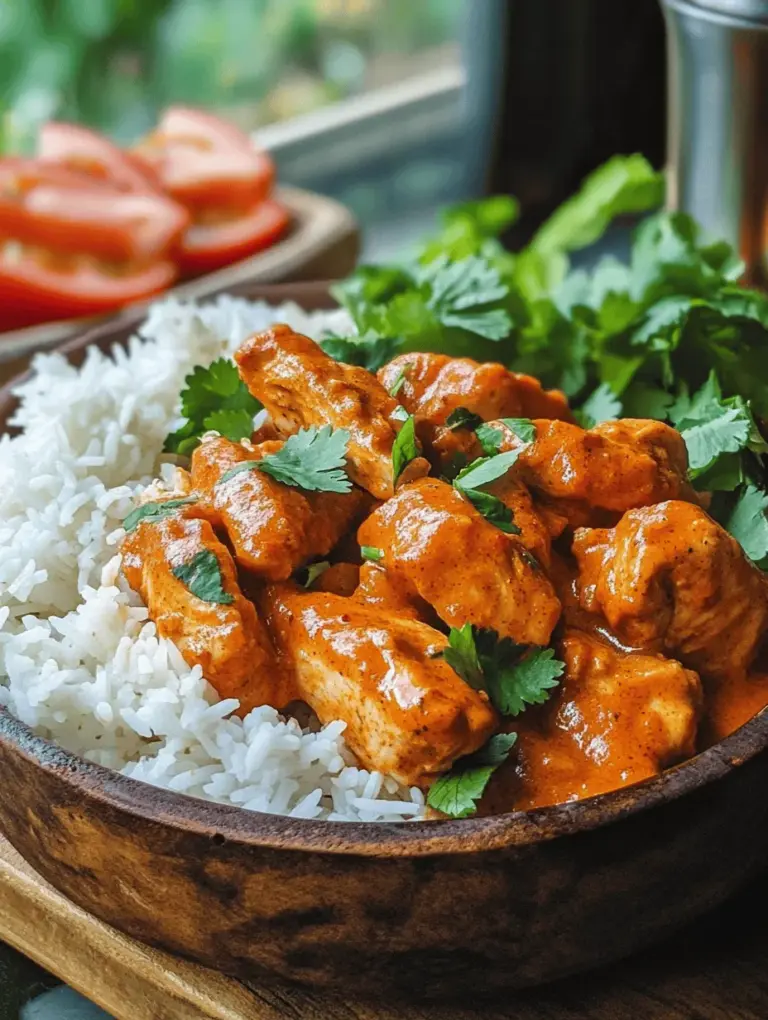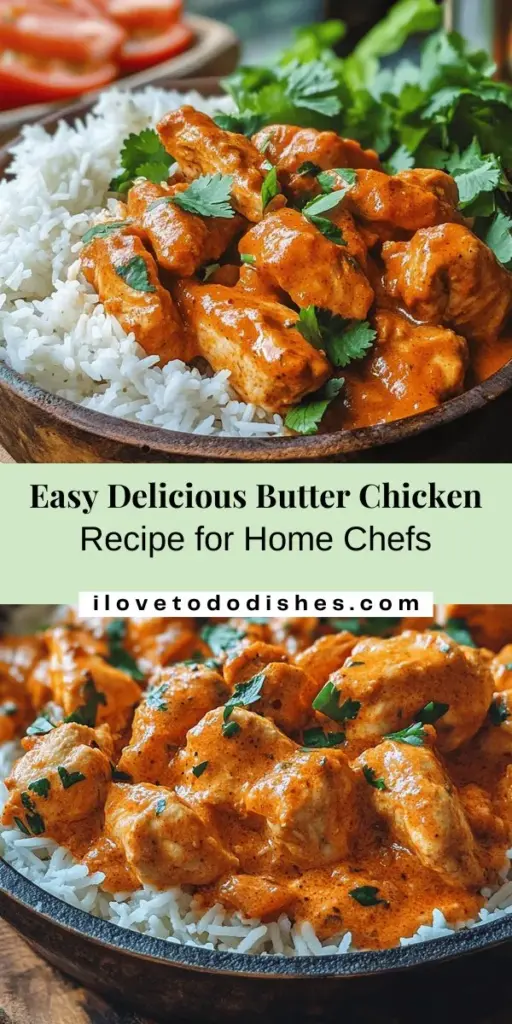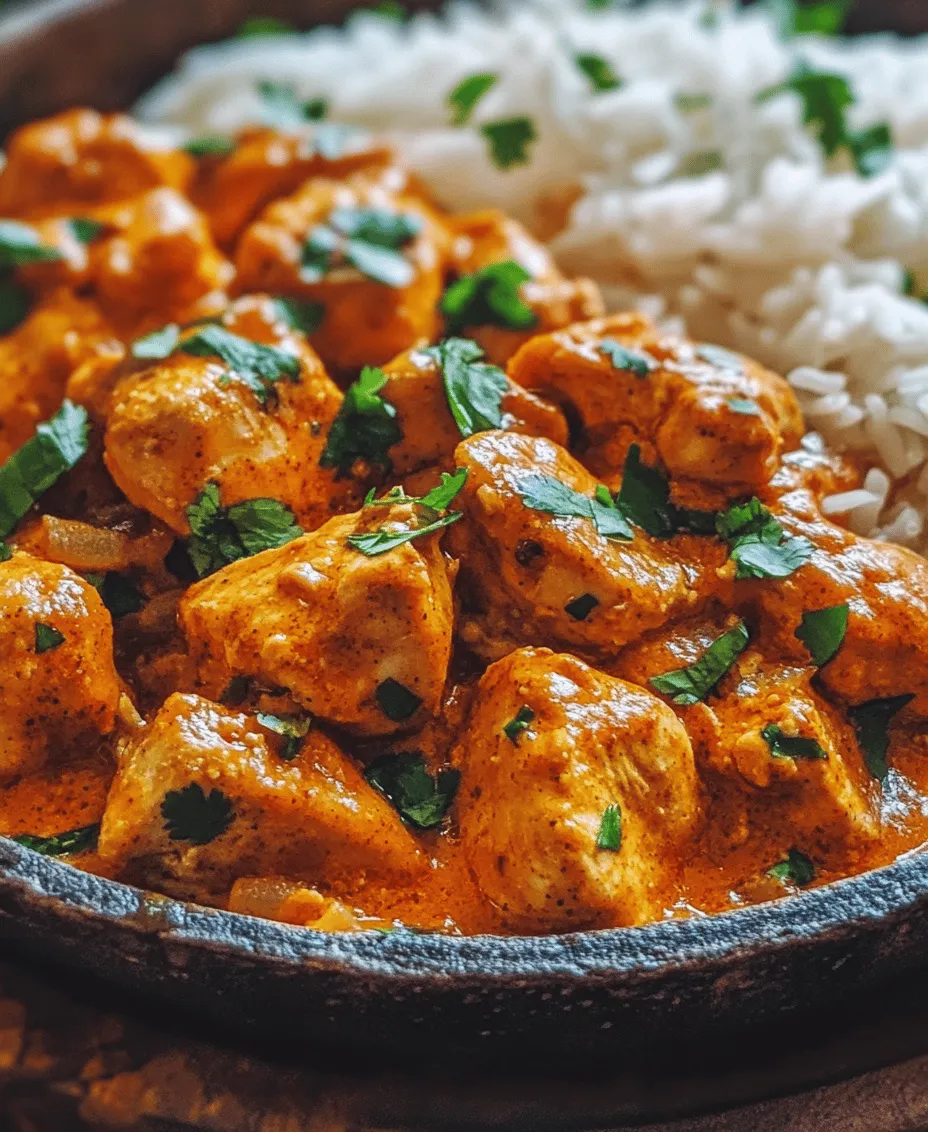Introduction
Welcome to the delightful world of Indian cuisine, where rich flavors and vibrant spices come together to create unforgettable dishes. Among these culinary treasures, butter chicken stands out as a beloved classic, known for its creamy texture and aromatic spices. This blog post will guide you through the process of making the best butter chicken recipe, offering a detailed look at the ingredients, cooking methods, and cultural significance. Whether you’re a seasoned chef or a novice in the kitchen, this comprehensive guide will empower you to recreate this restaurant-quality dish at home.
Butter chicken, or “Murgh Makhani,” as it is traditionally known, has captured the hearts of food lovers worldwide. Its origins can be traced back to the 1950s in Delhi, India, where chefs at the Moti Mahal restaurant first crafted this delectable dish. The story goes that leftover chicken from the tandoor (a traditional clay oven) was simmered in a rich tomato-based sauce, enriched with butter and cream. This innovative approach transformed what could have been a waste into a culinary masterpiece, forever changing the landscape of Indian cuisine.
Understanding Butter Chicken
Exploring the Origins of Butter Chicken
Butter chicken has a fascinating history that intertwines with the evolution of Indian cooking. The dish emerged during a time when Indian cuisine was becoming more accessible to a global audience. With its roots in Punjabi cooking, butter chicken reflects the region’s love for hearty meals and bold flavors. The introduction of butter and cream into the dish not only enhanced the taste but also made it more appealing to those unaccustomed to the spicier elements of traditional Indian fare.
The cultural significance of butter chicken extends beyond its taste. It symbolizes the warmth of Indian hospitality, often served at family gatherings and festive occasions. The dish has transcended its humble beginnings to become a staple in Indian restaurants around the world, celebrated for its comforting qualities and rich flavor profile.
The Appeal of Butter Chicken
So, what makes butter chicken such a favorite among food lovers? First and foremost, it is the unique flavor profile that distinguishes this dish from others. The combination of tender chicken, aromatic spices, and a velvety sauce creates an indulgent experience that tantalizes the taste buds. The balance of flavors—from the tanginess of tomatoes to the creaminess of butter—ensures that every bite is a delicious delight.
Additionally, butter chicken’s texture plays a crucial role in its appeal. The sauce is thick and luscious, clinging to the chicken pieces and making it perfect for pairing with naan or rice. This dish is not just about satisfying hunger; it’s about creating a memorable dining experience. Whether enjoyed at a restaurant or made at home, butter chicken has a way of bringing people together, making it an ideal choice for gatherings and celebrations.
Ingredients Overview
To create the best butter chicken, it’s essential to understand the key ingredients that contribute to its signature taste and texture. Each component plays a vital role in building the dish’s complex flavor profile.
The Role of Chicken Thighs in Achieving Tenderness
While some recipes may call for chicken breasts, using chicken thighs is highly recommended for butter chicken. Thighs have a higher fat content, which not only adds moisture but also enhances the overall flavor. This cut of meat remains juicy and tender even when cooked in a rich sauce, ensuring a delightful eating experience. When selecting chicken for your butter chicken, opt for bone-in, skinless thighs for the best results.
Importance of Marination: Yogurt, Lemon Juice, and Spices
Marination is a crucial step in preparing butter chicken, as it significantly impacts the flavor and tenderness of the chicken. The primary ingredients for the marinade include yogurt, lemon juice, and a blend of spices.
– Yogurt: The acidity in yogurt helps to tenderize the meat, breaking down proteins and allowing for better absorption of flavors. It also adds a subtle tanginess that complements the dish beautifully.
– Lemon Juice: A splash of lemon juice enhances the marinade’s acidity, further contributing to the tenderization process while adding brightness to the overall flavor.
– Spices: Traditional spices such as garam masala, cumin, coriander, and turmeric are essential for creating the authentic taste of butter chicken. These spices impart warmth, earthiness, and depth to the dish.
The Impact of Fresh Ingredients Like Garlic, Ginger, and Onion
Fresh ingredients are pivotal in elevating the flavors of butter chicken. The aromatic combination of garlic, ginger, and onion forms the base of the sauce, providing a fragrant and flavorful foundation.
– Garlic: Adds a robust flavor that complements the spices and enhances the overall depth of the dish.
– Ginger: Provides a warm, spicy note that balances the richness of the sauce.
– Onion: When sautéed, onions develop a sweet and savory flavor, contributing to the sauce’s complexity.
Utilizing fresh ingredients ensures that the butter chicken is not only flavorful but also aromatic, filling your kitchen with enticing scents as you cook.
Understanding the Significance of Heavy Cream and Butter in the Sauce
The name “butter chicken” itself hints at the key ingredients that make up its luscious sauce. Heavy cream and butter are essential for achieving the dish’s signature richness and creaminess.
– Heavy Cream: This ingredient is responsible for the smooth, velvety texture of the sauce. It adds a luxurious quality that envelops the chicken and creates a comforting, indulgent experience.
– Butter: In addition to contributing to the creaminess, butter enhances the overall flavor profile, providing a rich, savory note that elevates the dish. The use of unsalted butter allows for better control over the seasoning.
Together, these ingredients work harmoniously to create a sauce that is both rich and balanced, making butter chicken a truly satisfying meal.
Marinating the Chicken
The science behind marination is crucial for achieving the best butter chicken. Properly marinating the chicken not only infuses it with flavor but also ensures that it remains tender and juicy during cooking.
How Yogurt and Spices Tenderize the Chicken
The acidic nature of yogurt plays a significant role in tenderizing the chicken. As it sits in the marinade, the yogurt breaks down the proteins, allowing the spices to penetrate the meat more effectively. This process results in chicken that is flavorful and tender, making it ideal for cooking in a rich sauce.
Recommended Marination Times for Optimal Flavor
For optimal flavor and tenderness, it’s essential to allow the chicken to marinate for a sufficient amount of time. A minimum of 1 hour is recommended, but for best results, marinate the chicken overnight in the refrigerator. This extended marination time allows the flavors to develop fully, ensuring that every bite is bursting with deliciousness.
Step-by-Step Guide to Marinating
Ingredients for the Marinade:
– 1 cup plain yogurt
– 2 tablespoons lemon juice
– 2 teaspoons garam masala
– 1 teaspoon ground cumin
– 1 teaspoon ground coriander
– 1 teaspoon turmeric
– 1 teaspoon red chili powder (adjust to taste)
– Salt to taste
– 2 pounds chicken thighs, cut into bite-sized pieces
Instructions for Preparing the Marinade:
1. In a large mixing bowl, combine the yogurt, lemon juice, garam masala, cumin, coriander, turmeric, red chili powder, and salt.
2. Whisk the ingredients together until well combined.
3. Add the chicken pieces to the marinade, making sure they are evenly coated.
Tips for Ensuring Even Coating of Chicken Pieces
To ensure that each piece of chicken is thoroughly coated with the marinade, consider the following tips:
– Use your hands to massage the marinade into the chicken, ensuring that the mixture reaches every corner of the meat.
– Cover the bowl with plastic wrap or transfer the chicken to a resealable plastic bag, ensuring that the marinade is in contact with all surfaces of the chicken.
– Refrigerate for the recommended marination time, allowing the flavors to meld and penetrate the meat.
By following these steps, you will set the foundation for a delicious butter chicken that is bursting with flavor and tenderness.
Cooking the Chicken
Once the chicken has marinated, it’s time to move on to the cooking process. The technique used for cooking the chicken is essential for achieving that perfect balance of tenderness and flavor.
While the cooking method may vary, a popular approach is to sear the marinated chicken pieces in a hot skillet or tandoor before simmering them in the sauce. This technique not only enhances the flavor but also adds a beautiful char to the chicken, further enriching the final dish.
Preparing to Cook
1. Begin by heating a large, heavy-bottomed skillet or Dutch oven over medium-high heat. Add a tablespoon of oil (such as vegetable or ghee) to the pan.
2. Once the oil is shimmering, add the marinated chicken pieces in batches to avoid overcrowding the pan. This will allow for even cooking and browning.
3. Sear the chicken for about 4-5 minutes on each side, until golden brown. The goal is to develop a nice crust without fully cooking the chicken, as it will continue to cook in the sauce.
Building the Sauce
After searing the chicken, the next step is to build the rich sauce that will envelop the meat. This involves sautéing the aromatics (onion, garlic, and ginger), adding the tomatoes and spices, and finally incorporating the cream and butter.
1. Remove the seared chicken from the skillet and set it aside.
2. In the same skillet, add a bit more oil or butter if needed, and sauté finely chopped onions until they become translucent and golden brown.
3. Add minced garlic and ginger, cooking for an additional minute until fragrant.
4. Next, add pureed tomatoes and stir well. Let the mixture simmer for about 10 minutes, allowing the sauce to reduce and thicken.
5. Stir in the spices (garam masala, cumin, coriander, and red chili powder) and cook for another 2-3 minutes to toast the spices and enhance their flavors.
The process of cooking the chicken and building the sauce is where the magic happens. Each step contributes to the overall flavor and texture of the dish, making it a delightful experience to create and savor.
As we continue to explore the best butter chicken recipe, we will delve into the final steps of combining the chicken with the sauce, as well as tips for serving and enjoying this beloved dish. Stay tuned for the next part of our culinary journey!
Choosing the Right Pan and Oil for Cooking
When it comes to making the best butter chicken, the choice of pan and oil can significantly influence the final result. A heavy-bottomed pan, such as a cast-iron skillet or a Dutch oven, is ideal for this recipe. These types of pans distribute heat evenly, which helps in achieving a perfect sear on the chicken and prevents burning.
As for oil, a combination of ghee (clarified butter) and vegetable oil is often recommended. Ghee adds a rich, nutty flavor that complements the spices beautifully, while vegetable oil has a higher smoke point, which is essential for searing the chicken without burning. A 50-50 mix of both will ensure that you get the best of both worlds: flavor and cooking stability.
Tips for Achieving the Perfect Golden-Brown Exterior
A golden-brown exterior on your chicken is not just about aesthetics; it’s a sign of flavor development. Here are some tips to achieve this:
1. Don’t Crowd the Pan: If you add too many pieces of chicken at once, the temperature of the pan will drop, leading to steaming rather than searing. Work in batches to ensure each piece gets the heat it needs.
2. Pat Chicken Dry: Before cooking, pat the marinated chicken dry with paper towels. This helps achieve a better sear as moisture can create steam.
3. High Heat: Start with medium-high heat and adjust as necessary. You want to hear that sizzle as soon as the chicken hits the pan.
4. Leave it Alone: Resist the urge to move the chicken around too much. Allow it to develop a crust before flipping.
Creating a Flavorful Base for the Sauce
The foundation of your butter chicken sauce is crucial for developing deep flavors. The base consists primarily of sautéed onions, garlic, and ginger.
The Importance of Sautéing Onions, Garlic, and Ginger
Sautéing these ingredients releases their natural sugars and essential oils, which adds layers of complexity to your dish. Onions should be cooked until they are translucent and slightly caramelized, which takes about 10-15 minutes over medium heat.
Garlic and ginger should be added in the last few minutes of cooking the onions to prevent burning and to maximize flavor. The aromatic qualities of garlic and ginger infuse the oil, creating a fragrant base that is essential for the sauce.
Signs of Perfect Sautéing to Enhance Flavor
Knowing when to stop sautéing is key. Look for the onions to turn a golden-brown color, and for the garlic and ginger to become fragrant but not dark. If the garlic turns brown, it can impart a bitter taste, so watch closely during this step.
Once your base is ready, you’ll move on to the next critical step: preparing the sauce.
Preparing the Sauce
Building Layers of Flavor
Once your base of onions, garlic, and ginger is ready, it’s time to build the sauce. Start by adding crushed tomatoes to the pan. Cooking the tomatoes properly is essential for richness.
How to Properly Cook Crushed Tomatoes for Richness
Add the crushed tomatoes and let them simmer for about 10-15 minutes. This process allows the tomatoes to reduce and thicken, concentrating their flavor. You want the sauce to be vibrant and slightly darker, indicating that it has cooked down enough to enhance its natural sweetness.
The Introduction of Spices and Their Timing for Maximum Aroma
Timing is everything when it comes to spices. Once the tomatoes have reduced, it’s essential to add your spices—typically garam masala, cumin, turmeric, and coriander—at this point. Toasting the spices for a minute or so in the hot oil will release their essential oils and maximize their aroma.
Stir well to combine everything, ensuring the spices coat the tomatoes evenly. The fragrance that fills your kitchen at this moment will hint at the deliciousness to come.
Combining Chicken with the Sauce
Techniques for Integrating the Chicken Back into the Sauce
Once your sauce is bubbling and aromatic, it’s time to reintroduce the chicken. If you cooked the chicken in batches, ensure it’s all added back into the pan. Stir gently to coat the chicken pieces with the sauce.
Ensuring a Balance Between the Chicken and Sauce Flavors
Allow the chicken to simmer in the sauce for about 10-15 minutes. This step allows the chicken to absorb the flavors of the sauce while ensuring it’s cooked through. If the sauce seems too thick, you can add a splash of water or chicken broth to achieve your desired consistency.
Finishing Touches
Creating the Perfect Creamy Texture
The hallmark of a great butter chicken is its creamy texture. Once the chicken is cooked, it’s time to finish the sauce.
The Role of Heavy Cream and Butter in the Final Dish
Add heavy cream and a generous pat of butter to the sauce. The cream will provide that rich, velvety mouthfeel that butter chicken is known for, while the butter adds a final layer of richness and flavor. Stir this mixture well and adjust seasoning with salt and pepper to taste.
How to Achieve the Desired Consistency and Flavor Balance
If your sauce appears too thick, you can thin it with additional cream or a bit of water. The goal is to achieve a silky smooth sauce that clings to the chicken without being overly runny. Taste and adjust the seasoning if necessary.
Garnishing for Presentation
The Importance of Fresh Cilantro
Presentation is key in any dish, and garnishing your butter chicken with fresh cilantro adds a pop of color and freshness. Roughly chop a handful of cilantro and sprinkle it over the dish before serving.
Suggestions for Serving Accompaniments
Butter chicken is traditionally served with basmati rice and naan bread, which absorb the rich sauce beautifully. However, you can also consider serving it with:
– Jeera Rice: Flavored with cumin seeds, this rice dish complements butter chicken perfectly.
– Quinoa: For a healthier alternative, serve the butter chicken over quinoa.
– Vegetable Samosas: These provide a delightful crunch and contrast to the creamy sauce.
Serving Suggestions
Pairing Butter Chicken with Side Dishes
Butter chicken is versatile when it comes to pairing with side dishes. Here are some traditional and alternative options:
Traditional Options: Basmati Rice and Naan Bread
These are the classic accompaniments that provide a perfect balance of flavors and textures. The fluffy basmati rice soaks up the sauce, while naan is perfect for scooping.
Exploring Alternative Sides for a Unique Experience
For a different twist, consider serving your butter chicken with:
– Roti: A whole wheat flatbread that is lighter than naan.
– Cauliflower Rice: A low-carb option that is becoming increasingly popular.
– Chickpea Salad: A refreshing side that adds a protein punch and contrasts the richness of the butter chicken.
Conclusion
In conclusion, mastering the art of butter chicken is not only about following a recipe but also about understanding the flavors and techniques that bring this dish to life. From marinating the chicken to creating a rich and creamy sauce, each step is integral to achieving the perfect balance of taste and texture.
Whether enjoyed on a cozy night in or served at a gathering with friends and family, this butter chicken recipe promises to deliver a satisfying and memorable meal. Dive into this culinary adventure and savor the delightful experience of homemade butter chicken. With attention to detail and a touch of love, you’ll find that this dish is not just a meal, but an experience to be shared and cherished.



